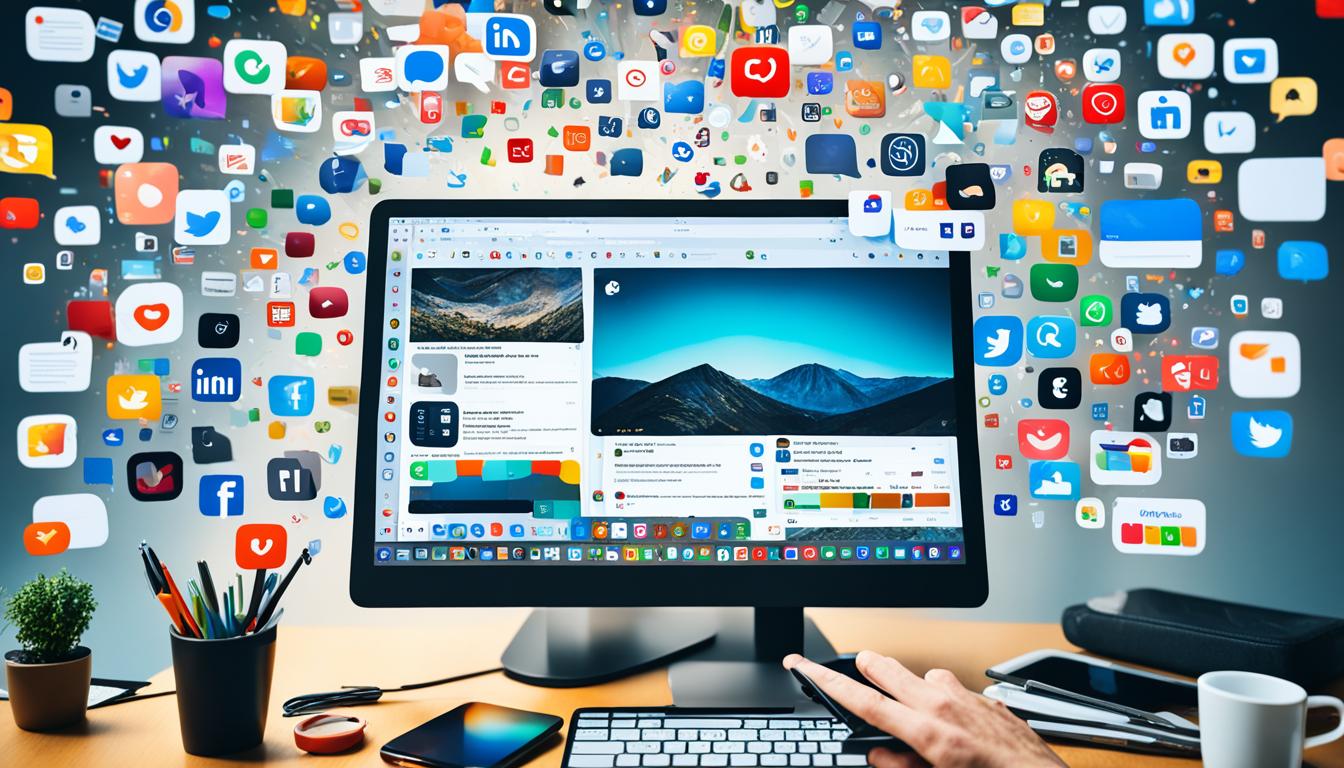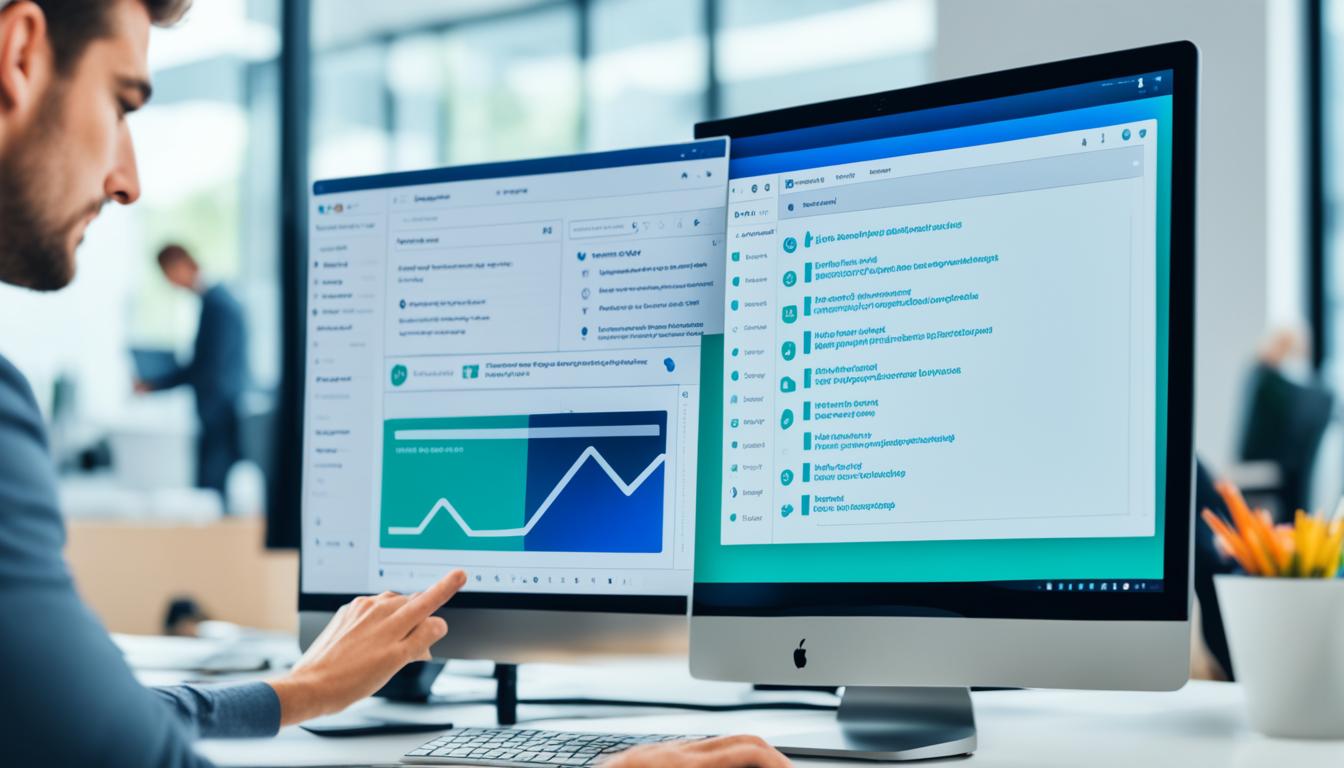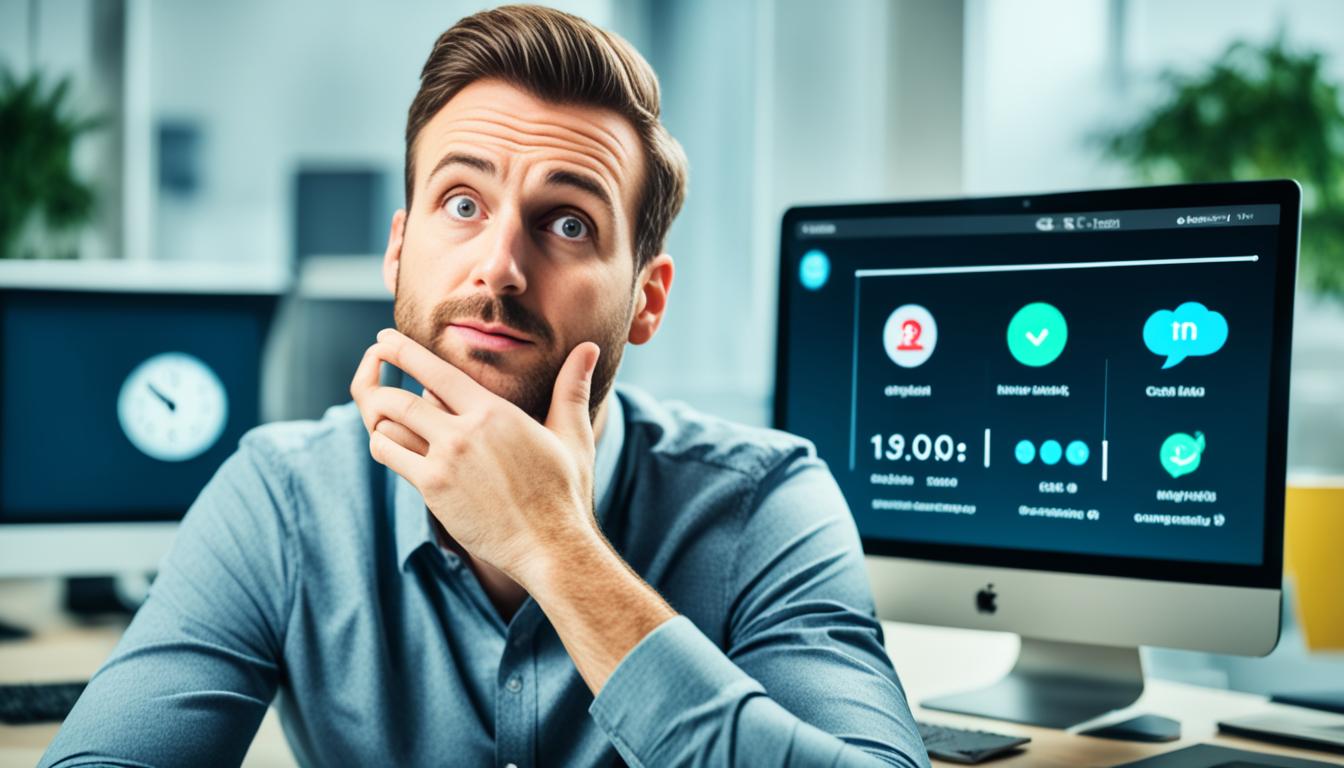Nowadays, smartphones and computers are a big part of our lives. But, they make it hard to stay focused. We get lots of messages and notifications that distract us. It’s key to fight these distractions to work better and get more done.

A study from the University of California, Irvine, found something interesting. After a distraction, it takes about 23 minutes to focus again. Small interruptions can really slow us down. McKinsey & Company says that better tech use could boost productivity a lot—by $1.3 trillion each year.
A survey by OSlash showed that 58% of people working from home get distracted by social media. Another 51% said that notifications are a big problem. These distractions don’t just bother us—they slow down whole companies too.
There are ways to deal with this, though. We can turn off our notifications and use social media less. Being more aware and using apps that help us focus can make a big difference. By trying these things, we can handle distractions better. This means we can focus more and do our best work.
Understanding Digital Distractions and Their Impact
Digital distractions come from many digital tools and platforms. They take our attention away from main tasks. Things like notifications and social media alerts are big distractions. They make us lose focus and lower our work quality.
What Are Digital Distrections?
Digital distractions include many things. Social media and email alerts are common ones. They make it hard to stay focused. A study shows multitasking with media makes us less efficient. These distractions hurt our ability to pay attention.
The Cost of Digital Distractions on Productivity
Digital distractions greatly affect our work. They make us spend too much time on email and social media. This lowers our productivity. Larry Rosen says taking breaks and using devices less helps. Being smarter with digital use also boosts work quality. It reduces the time lost to distractions.
Statistics on Time Lost Due to Distractions
It takes over 23 minutes to focus again after a distraction. More than 16,000 students shared this in a survey. The toughest thing to ignore is messaging and waiting for replies. Too much screen time can cause sleep problems and stress. Finding a balance with technology is key to staying productive.
Common Causes of Digital Distractions
Let’s explore why digital distractions are quite common today. Especially for those who work remotely. We will look at the main reasons behind these disruptions.
Access to Technology
Devices are always close by, making it tempting to check emails and social sites. On average, workers can’t last 40 minutes without checking their email. This shows how distractions are everywhere. In fact, about 90% of people working from home get distracted often. They are interrupted by digital messages about 14 times a day.
Social Media Overload
Social media aims to catch our attention with notifications and likes. This can lead to a habit that’s hard to break. People spend around two hours daily on social sites. Because of this, productivity drops. It also hurts our face-to-face chats, making us less present when we’ve just used our phones.
Instant Messaging Interruptions
Messaging apps also break our focus. A report by RescueTime found that people check these apps every six minutes. With notifications coming non-stop, it’s hard to stay focused. A big 40% of workers don’t get even 30 minutes without an interruption.
Client Pressures and Demands
Clients expecting quick replies also disrupt our work. The need to always check messages breaks our concentration. This makes a stressful work space where deep focus is hard to find.
How To Avoid Digital Distractions: A Comprehensive Guide
Avoiding digital distractions involves multiple steps. It includes being self-aware, making tech changes, and using productivity methods. A lot of U.S. teens say their school work suffers because of digital distractions. This shows why it’s key to find ways to avoid these distractions.
The Pomodoro Technique lets people work in 25-minute focused sessions, then break. This not only cuts digital interruptions but also boosts focus. Taking regular digital breaks also helps refresh your mind and improve focus.

Digital distractions can hurt how well we understand and remember info. Using the 20-20-20 rule can help prevent digital overload and protect your eyes. It’s also good to turn off notifications to keep focus.
Grouping tasks together makes you more efficient. Time-blocking sets specific times for tasks, helping you keep on track. Also, clean up your digital space to lessen distractions.
Tools like Cold Turkey Blocker and Opal help by blocking sites and apps that distract. Americans often check work email for 149 minutes a day. Limiting email checks is key for staying focused. Some companies, like Grant Thornton, don’t let emails and meetings happen on Friday afternoons to help employees focus.
Setting times for complex work can make you more efficient. Jessica E. McClain points out that this keeps momentum up. Tools and scheduling apps help John Fiske stay productive by organizing tasks well.
Being clear about when you’ll answer messages can ease clients’ minds. Sending emails at set times helps you work without breaks. Elizabeth Grace Saunders says true breaks recharge your mind, boosting productivity and reducing digital distractions.
The Role of Self-Awareness in Fighting Distractions
Self-awareness is key in fighting digital distractions. By knowing what sets us off, we can handle our feelings better. This way, we get our focus back.
Identifying Personal Triggers
Understanding what distracts us is a big win. People often check their phones due to feeling bored or antsy. Notice these moments to cut back on screen time. Freedom and Do Not Disturb mode are great tools for this. They help our brain get used to less distraction.

Understanding Emotional Responses
Knowing why distractions lure us is part of the battle. People turn to their phones or social media to dodge tough tasks. By tackling these urges smarter, we grow both professionally and personally. Taking breaks from digital devices helps a lot.
It’s also crucial to see how trying to do many things at once wears us down. People who multitask remember less and do worse than those who focus. To stay on track, keep a to-do list and use apps that help focus.
Turning Off Notifications to Stay Focused
In today’s world, it’s important to handle notifications well. This is key to cut down on digital noise and stay focused. Getting too many alerts, especially from social media, can make us anxious and less productive. Properly handling these alerts can improve our sleep, focus, and overall health.
Steps to Disable Disruptive Notifications
To work better, begin by turning off notifications that you don’t need. Here are some steps to follow:
- Figure out which notifications bother you the most. Social media and messaging apps are usually the culprits.
- Go to your device’s settings to turn these notifications off. For example, on iOS, go to Settings > Notifications and pick the app. On Android, it’s Settings > Apps > Notifications.
- If an app is too distracting, you might want to uninstall it. Some people remove Facebook or Instagram.
- To limit distractions further, use tools like Shift. They let you turn off the counter for unread emails and apps, making your workspace tidier.
Effectiveness of ‘Do Not Disturb’ Mode
The ‘Do Not Disturb’ feature can also help manage notifications. It has several benefits:
- It lowers anxiety and interruptions, so you can focus better.
- Your sleep might improve since it blocks late-night alerts. This is good because late-night light can mess with sleep.
- It helps you be more present with others. By keeping your phone away during important times, your connections improve.
- It encourages using technology more mindfully. For instance, people might put away their phones during meals for better conversations.
Being disciplined with notifications can really help. Set times to check messages. Use ‘Do Not Disturb’ to cut down on interruptions. This can make you more productive.
Setting Boundaries with Social Media Usage
In our digital world, setting boundaries with social media is key. It helps keep our focus at work and improves our well-being. Too much screen time can cause problems like eye strain, sleep issues, stress, and anxiety. By having clear rules with our tech use, we can dodge these troubles and use our devices in a healthier way.

Limiting Social Media to Specific Times
One way to cut down on social media’s negative effects is to use it only at certain times. For example, using social media for just two hours daily can stop you from scrolling without thinking. This helps keep you focused. Also, having times when you don’t use screens at all can help your eyes. It can also make sleep better. Plus, it helps families talk more during meals and rest well.
Having fixed times to check social media also reduces feelings of envy from comparing ourselves to others online.
Uninstalling Non-Essential Apps
Getting rid of apps you don’t really need is another key step. This can cut down on distractions. Making areas in your home free from devices and having times when you disconnect can help, too. This ensures you spend time on important things and physical activities. Such actions improve our health and make relationships within families stronger.
It’s also good to keep checking and adjusting how you use technology as new stuff comes out. By controlling notifications and setting limits on social media use, grown-ups can avoid getting too tired. They can keep a good balance between work and life.
Benefits of Taking Digital Detox Breaks
Today, folks in the U.S. watch TV for about four hours daily. They also use digital devices for nearly 7.5 hours. Such a lot of screen time has big effects. It leads to checking smartphones 96 times a day on average. People also spend over two hours on social media. This constant use can make people feel anxious, sad, and have poor self-esteem.
Taking breaks from digital devices can really make life better. After a digital detox, people often feel more focused, less stressed, and get along better with others. Studies show that staying away from digital distractions helps with managing time better. It also stops the compulsive need to use devices all the time.
If you feel down, easily upset, insecure, can’t sleep, or must check your gadgets a lot, you might need a digital detox. Starting a detox means setting clear goals. You must decide to do it for at least two weeks. Get some support, stick to your plan, and check how you’re doing often.
The average person in the U.S. uses about 11 hours of media each day. Cutting back has clear benefits. About 18% of U.S. adults feel stressed because of technology. Young people who use a lot of tech have problems like bad sleep, feeling depressed, and more stress. Less screen time, especially before sleep, helps you sleep better and be less sleepy during the day.
It’s very important to take breaks from screens from time to time. These breaks help you rest, focus better, and use your devices more wisely. Turning off your devices now and then is key for your mind’s health and being more productive.
Rewarding Yourself to Stay Motivated
Having a reward system can make you more motivated and productive. By setting goals and giving yourself rewards, you stay eager to work. This way, you’ll always be excited to get things done.
Types of Rewards to Consider
Rewards can vary based on what you like. You might enjoy a bit of social media, eating something tasty, or watching a show. It’s about choosing rewards that you really want.
Scheduling Reward Breaks
Scheduling rewards at the right times can make a big difference. It’s good to take breaks for fun between work times. This keeps you motivated and keeps your work on track. Studies show 70% of people work better when they have rewards waiting.
Utilizing Productivity Apps
Productivity apps have changed how we handle our work and time. They help us stay focused and efficient in today’s digital world. Many workers feel stressed by their emails, spending up to three hours daily on them. Using productivity apps can save time and lower stress.
These apps reduce interruptions and help us better use our work hours. Time management and workflow tools make a big difference.
Best Productivity Apps to Try
Some apps are great for improving efficiency and cutting down on digital distractions. FocusMe is popular for helping users meet their productivity goals. Serene and Forest also help keep distractions away. Over 40% of people use these apps to do better at work.
LeechBlock blocks sites that draw you away from work. Thousands find it handy to stay on task. It lessens the number of pop-ups and interruptions from apps fighting for your attention.
How to Set Up Time-Tracking Tools
Time-tracking tools are key for anyone wanting to work better. Tools like TimeFlip and OSlash help you schedule time to focus. They show how long different tasks take. This helps you plan better.
Using LeechBlock to keep off distracting websites helps too. It makes you more focused and productive. The average worker uses many apps daily. Using fewer can make your workday smoother.
In the end, productivity apps and tools are very helpful. They can block distracting sites and manage social media time. This makes sure you stay focused all day.
Embracing Behavioral Techniques to Reduce Digital Usage
Behavioral strategies help manage how much time we spend on our devices. People check their phones up to 58 times a day. Most of these checks happen while they are working. The Pomodoro Technique is a good way to stay focused. You work for 25 minutes straight and then take a short break. This helps keep your mind fresh and avoids burnout.
Taking a break from gadgets one day a week can help a lot. Nearly half of people feel they can’t focus as well as they used to. A digital detox lets your brain reset. Also, rewarding yourself for not getting distracted can make a big difference. A small treat after working without pause can lift your spirits and keep good habits going.
Being mindful about how you use technology is key. It makes for a better balance between work and life, and lowers stress. Many get stressed by too many emails. They get interrupted by digital tools about 14 times each day. By managing your time better, setting clear goals, and communicating wisely, you can work better and feel better too.
FAQ
What Are Digital Distractions?
Digital distractions include tools like social media and games. They make us lose focus on our tasks. Notifications and instant messages often cause this.
The Cost of Digital Distractions on Productivity?
These distractions hurt our work a lot. It can take over 23 minutes to get focused again after one. This results in lost productivity and could cost the economy greatly.
What Are the Statistics on Time Lost Due to Distractions?
Research shows distractions make us much less efficient. Each one can waste over 23 minutes. Over time, this adds up to a lot of lost productivity in a day.
What Are the Common Causes of Digital Distractions?
Many things cause distractions. Easy access to technology and lots of social media use are big ones. So are constant messages and the need to reply fast to clients.
How Can Access to Technology Lead to Distractions?
Since we’re always around technology, it’s easy to get distracted. Things like notifications and the internet grab our attention, making it tough to stay focused.
How Does Social Media Overload Affect Productivity?
Social media is made to get our attention. It leads to big distractions. The non-stop notifications and wanting to check it can really disrupt our work and make us less productive.
How Do Instant Messaging Interruptions Impact Efficiency?
Messages can interrupt us a lot, breaking our focus. Feeling like we need to reply right away can mess up our work and make us lose track of what we were doing.
How Do Client Pressures and Demands Contribute to Digital Distractions?
Having to answer clients right away means we’re always checking our devices. This interrupts our work and makes it hard to stay focused.
How Can Self-Awareness Help in Fighting Digital Distractions?
Knowing what causes our distractions and how we react to them can help. Understanding these can lead to better ways of staying focused.
What Are Some Emotional Responses That Lead to Digital Distractions?
Feelings like boredom, worry, or stress might make us turn to our devices for a distraction. Knowing these triggers can help us handle them better.
What Are some Steps to Disable Disruptive Notifications?
You can turn off notifications that aren’t important, use ‘Do Not Disturb,’ and pick which alerts you get. This helps keep our focus better.
How Effective Is the ‘Do Not Disturb’ Mode?
‘Do Not Disturb’ is great for keeping our focus. It stops calls, messages, and notifications from bothering us so we can work without breaks.
How Can Setting Boundaries with Social Media Usage Help?
Having set times for social media, removing apps you don’t need, and limiting use can help keep our focus during work.
What Are the Benefits of Taking Digital Detox Breaks?
Taking breaks from digital stuff helps us refocus, depend less on tech, and find a good balance. Short breaks can make us more focused and less tired of screens.
What Types of Rewards Can Help Stay Motivated?
Things like a social media break, a favorite treat, or fun activities can be good rewards. These help keep us on track and enjoy our breaks.
How Can Productivity Apps and Time-Tracking Tools Help?
Apps like TimeFlip and OSlash set times for focusing and limit distractions. Tools for tracking time help us do tasks well and organize our digital work better.
What Are the Best Practices for Setting Up Time-Tracking Tools?
Pick the best tool for you, set times for tasks, check your progress, and adjust as needed. This helps improve how you work.
How Can Behavioral Techniques Help in Reducing Digital Usage?
Setting goals, using techniques like Pomodoro, and managing emails well can help us stay on task. This reduces stress and makes us healthier in a world full of digital distractions.

More Posts
Weekly Digest for Effective People #6
May 7 to May 13
10 Best Project Management Software for Mac
Looking for top-tier Project Management Software for Mac? Well, you’re in luck. Today, We get into some of the most powerful tools to help you streamline your projects like a pro. So, buckle...
10 Ideas for Increasing Productivity in Your Weekly Workflow
Having a plan for improving workflow and productivity is the key to getting great results without wasting time and resources. By using productivity strategies and improving current processes, teams can beat inefficiencies. This...
Avoid these Common Mistakes for a Productive Monday Morning
 Monday mornings are often seen as tough. 80% say it's the week's most stressful day. This stress comes from too much work, too...